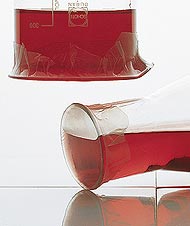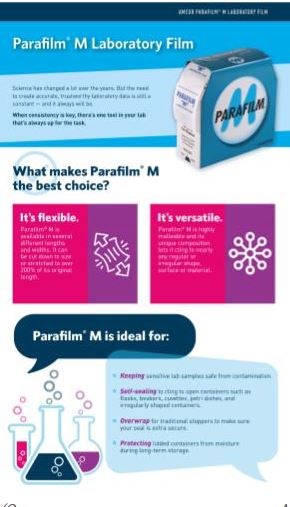Parafilm is a semi-transparent sealing film that is used widely in labs and beyond since it was invented in the USA in 1936. It is composed of a proprietary combination of waxes and polyolefins and has the incredible ability to stretch to over 200% of its original length. It can cling to and seal vessels of almost any shape and material and this makes it incredibly versatile. Parafilm is moisture resistant but has gas permeability.




Parafilm Overview
Parafilm is ideal for a range of applications in the lab and beyond and this includes:
- Creating a physical barrier and seal over samples – keeping your wok safe from contamination.
- Sealing of containers in a huge variety of shapes and sizes including flasks, dishes, tubes and more.
- Using to overwrap stoppers to ensure they are held securely in place.
- Protecting containers with lids from moisture during storage. Parafilm will prevent moisture and volume loss but it is also permeable to oxygen, carbon dioxide and water vapour. Therefore it allows for off-gassing without compromising the sample integrity.
Parafilm Frequently Asked Questions:
Is PARAFILM free of latex?
PARAFILM®M is free from plasticizers and consists primarily of polyolefins and paraffin waxes. If PARAFILM®M comes into contact with food, the relevant regulations should be observed.
At what temperature can I use PARAFILM?
Temperature range (continuous use): -45 to +50°C, melting point: 60°C, flash point: 301°C.
How long can I store PARAFILM?
Parafilm® M can be stored at least 3 years, without quality impairment, under storing conditions between 7 °C and 32 °C at 50 % relative humidity.
Is there any information about gas permeability and water vapor permeability of PARAFILM.
Parafilm’s predictable oxygen transmission rates (OTR) helps to keep your experiments consistent.
Gas permeability in 24 hours at 23 °C and 50% relative humidity:
– O2 (oxygen): ≤ 350cm³/m²
– N2 (nitrogen): ≤ 105cm³/m²
– CO2 (carbon dioxide): ≤ 1100cm³/m²
– Water vapor permeability in 24 hours at 37 °C and 90% relative humidity: 0.8 g/m² (Vapor pressure from volatile substances may lift PARAFILM®M off the edge of the vessel.)
Is there any information available about the chemical resistance of PARAFILM?
PARAFILM®M is resistant up to 48 hours against many polar substances, e.g. saline solutions, inorganic acids and alkaline solutions. After this period embrittlement may occur.
Effects of 48 hours exposure at 23°C:
| Acids | Hydrochloric acid 36.5% | resistant |
| Sulphuric acid 98% | resistant | |
| Nitric acid 95% | resistant (brown discoloration) | |
| Alkaline solutions | Sodium hydroxide 22% | resistant |
| Ammonia 28% | resistant | |
| Saline Solutions | Sodium chloride 20% | resistant |
| Potassium permanganate 5% | resistant (brown discoloration) | |
| Iodine solution 0.1 mol/l | resistant (brown discoloration) | |
| Organic solvents | Methyl Alcohol (Methanol) | resistant |
| Ethyl Alcohol (Ethanol) | resistant | |
| Isopropyl alcohol | resistant | |
| Diethyl ether | not resistant | |
| Chloroform | not resistant | |
| Carbon tetrachloride | not resistant | |
| Benzene | not resistant | |
| Toluene | not resistant |
closing text paragraph
















